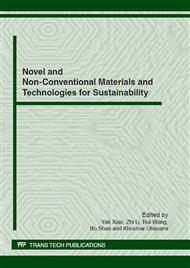[1]
Dantas, R. R. Relatório de estágio supervisionado na CAULISA, Indústria de Caulim – S/A, Campina Grande –PB, (1983).
Google Scholar
[2]
Dantas, K.C.B.; Nóbrega, A.F.; Ribeiro, P.H.L.C.; Torres, S.M.; Barbosa, N.P. Avaliação do potencial de reciclagem de resíduos do beneficiamento do caulim na construção civil: Mineralogia, índices físicos, cominuição e atividade pozolânica. IAC - BRASIL NOCMAT 2006 - Salvador, BA, Brasil, Octuber 20th – November 01th (2006).
DOI: 10.47749/t/unicamp.2015.949162
Google Scholar
[3]
Nóbrega, A.F.; Dantas, K.C.B.; Oliveira, M.P.; Torres, S.M.; Barbosa, N.P. Avaliação do desempenho de Argamassas com o uso de Rejeito de Caulim Industrial como Material de Substituição do Cimento Portland, IAC-NOCMAT 2005–Rio Rio de Janeiro, RJ, Brazil, November 11th - November 15th (2005).
DOI: 10.1590/s1415-43662006000200034
Google Scholar
[4]
Nóbrega, A.F.; Dantas, K.C.B.; Torres, S.M.; Sobrinho Jr, A.S.; Barbosa, N.P. Resíduos de Caulim em Argamassas de Múltiplo Uso: Efeito da Granulometria no Desempenho Mecânico, IAC- BRASIL NOCMAT 2006 - Salvador, BA, Brasil, 20 de Outubro a 01 de Novembro de (2006).
DOI: 10.29381/0103-8559/2020300187-91
Google Scholar
[5]
Nóbrega, A.F.; Oliveira, M.P.; Torres, S.M.; Polari Filho, R.S.;A.S.; Barbosa, N.P.; Araújo, J.L. Potencial do Uso do Rejeito de Caulim Industrial como Material de Substituição de Cimento Portland. In: 47o Congresso Brasileiro do Concreto, 2005, Recife. Anais do 47o Congresso Brasileiro do Concreto, 2005. v. v. p.
DOI: 10.29327/140860
Google Scholar
[6]
Nóbrega, A.F. Potencial de aproveitamento de resíduos de caulim paraibano para desenvolvimento de argamassas de múltiplo uso. Dissertação de Mestrado, Programa de Pós-graduação em Engenharia Urbana da Universidade Federal da Paraíba, (2007).
DOI: 10.1590/s0103-21002009000100001
Google Scholar
[7]
ABNT, NBR 7217-Agregado – Determinação da composição Granulométrica. Associação Brasileira de Normas Técnicas, Rio de Janeiro, (1994).
Google Scholar
[8]
Alves, S M - Desenvolvimento de Compósitos Duráveis e Resistentes Através da Substituição Parcial do Cimento por Resíduo da Indústria Cerâmica. Dissertação de Mestrado, Programa de Engenharia Mecânica, Universidade Federal da Paraíba, João Pessoa, Set. (2002).
DOI: 10.17648/coen-2018-89457
Google Scholar
[9]
ABNT, NBR 5751 - Índice de atividade pozolânica com a cal. Associação Brasileira de Normas Técnicas, Rio de Janeiro, (1992).
Google Scholar
[10]
ABNT, NBR 7215-Determinação da resistência à compressão - Cimento Portland. Associação Brasileira de Normas Técnicas, Rio de Janeiro, (1996).
Google Scholar
[11]
ABNT, NBR 13276-Determinação do teor de água para obtenção do índice de consistência padrão - Argamassa para assentamento de paredes e tetos. Associação Brasileira de Normas Técnicas, (1995).
DOI: 10.47749/t/unicamp.1978.48411
Google Scholar
[12]
DAVIDOVITS, J. Geopolymers: inorganic polymeric new materials. Journal of Thermal Analysis 37, 1633 (1991).
DOI: 10.1007/bf01912193
Google Scholar
[13]
DAVIDOVITS, J. Materials for the third millennium. Think geopolymer and geosynthesis. Disponível em: <http: /www. geopolymer. org/applications. html>. Acesso em: 04 Set (2004).
Google Scholar
[14]
DAVIDOVITS, J. Synthetic mineral polymer compound of silicoaluminates family and preparation process. US Patent 4. 472. 199 (1984). 18 Set (1984).
Google Scholar
[15]
PALOMO, A.; GRUTZECK, M.W.; BLANCO, M.T. Alkali-actived fly ashes. A cement for the future. Cement and Concrete Research 29, 1323 (1999).
DOI: 10.1016/s0008-8846(98)00243-9
Google Scholar
[16]
XU, H.; VAN DEVENTER, J.S.J. The geology merisation of alumino-silicate minerals. International Journal Mineral Processing 59, 247 (2000).
DOI: 10.1016/s0301-7516(99)00074-5
Google Scholar
[17]
BARBOSA, V.F.F.; Mackenzie, K.J.D.; THAUMATURGO, C. Synthesis and characterization of materials based on inorganic polymers of alumina and silica: sodium polysialate polymers. International Journal of Inorganic Materials 2, 309 (2000).
DOI: 10.1016/s1466-6049(00)00041-6
Google Scholar
[18]
BEAUDOIN, J.J. Properties of Portland cement paste reinforced with mica flakes. Cement Concrete Research. 13, pg. 156-160, (1999).
DOI: 10.1016/0008-8846(83)90097-2
Google Scholar
[19]
VAN JAARSVELD, J.G.S.; VAN DEVENTER, J.S.J. Effect of the alkali metal activator on theproperties of fly ash – based Geopolymers. Industrial and Engineering Chemistry Research. 38, 3932(1999).
DOI: 10.1021/ie980804b
Google Scholar


